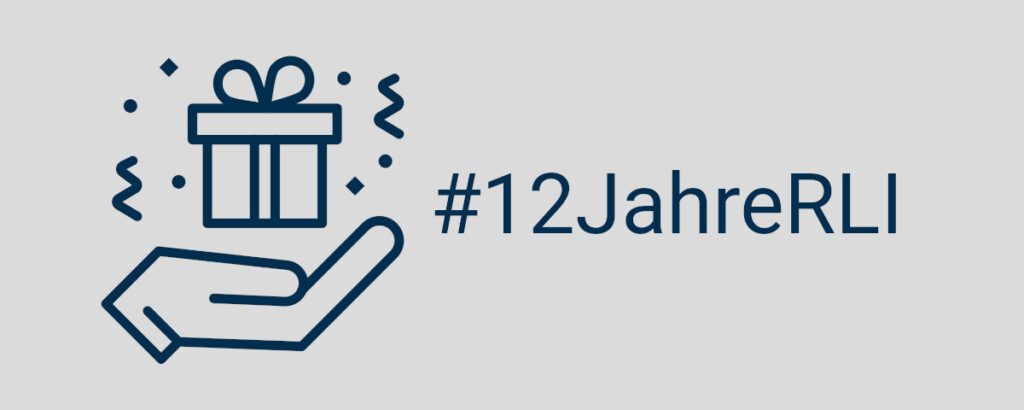Twelve years RLI – Twelve years of successful research for the energy transition
February 8<sup>th</sup>, 2022 | The Reiner Lemoine Institute turns twelve. Since its founding on February 8, 2010, the institute’s staff has been committed to a future with 100 percent renewable energies. Twelve years of RLI, that now means: three research areas, more than 100 employees, guest researchers and scholars, more than a dozen tools and platforms, one spin-off and more than 350 projects for the energy transition.
“It’s great to see all we’ve accomplished as RLI. I’m particularly proud of the people who work for us because they are committed to a livable future, both professionally and privately – and this is visible in our work,” says Kathrin Goldammer. She leads the RLI since six years. “Our team does Open Science, electromobility and electrification in developing countries with full conviction. And we want to get along well with each other and support each other in our work. That’s what makes RLI a unique place in energy research.”
The RLI’s projects make practical progress in the energy transition visible. Twelve examples of twelve years of successful work at RLI.
Green light for the traffic transition
The work for the transport turnaround of the research field Mobility with Renewable Energies becomes visible in very different ways.
In the E-Metrobus project, 17 electric buses of the Berliner Verkehrsbetriebe (BVG) travel through Berlin on line 200. The E-Metrobuses can be charged particularly quickly to meet the demands of regular service buses in Berlin’s city traffic.
Berliners were also able to see the work of the e-mobility team at the Südkreuz S-Bahn station. And they could also use it: Two small wind turbines and two photovoltaic systems on the station grounds supplied a car and bike sharing station with their energy.
For the German government’s National Organization Hydrogen and Fuel Cell Technology (NOW), the Mobility with Renewable Energies team found out in the study “Charging infrastructure after 2025/2030: Scenarios for market ramp-up” the need for charging infrastructure in Germany for e-vehicles will be in 2030: 440,000 to 843,000 charging points will be needed by 2030. They will have to supply electricity to the estimated 14.8 million e-vehicles and plug-in hybrids.
And the team is not only familiar with electricity, but also with hydrogen. The research unit developed a hydrogen roadmap for Brandenburg. The roadmap is now part of the state’s hydrogen strategy. The Brandenburg Ministry of Economics, Labor and Energy is working on implementing the 63 measures.
Electrification around the world
The team in the Off-Grid Systems research unit creates solutions for the electrification of developing regions. Always on the basis of renewable energies. Often with the help of geoinformation systems.It is the most widely traveled team at RLI. In the past twelve years, researchers have been active in projects in more than 30 countries, including Asia, Africa, Latin America and the Caribbean.
In the Philippines, scientists from the off-grid team worked on the Access to Sustainable Energy Programme (ASEP) project to harness renewable energy for power supply in the Southeast Asian country.
In the Nigerian Energy Support Programme (NESP), RLI staff created an electrification roadmap for five Nigerian states. Mini-grids and solar systems were among the options included in the planning.
Eleven international partner institutions are involved in the project “People Power: Optimizing Off-Grid Electricity Supply Systems in Nigeria”(PeopleSuN). Technical solutions are not the only focus here. The main aim is to develop an understanding of local needs and a realistic financial framework in order to optimize the use of off-grid systems. Therefore, 5000 households in Nigeria were surveyed about their energy needs.
A planning tool will be the result in the Open_plan project: A planning tool for the optimized planning of energy cells for the (partial) supply of electricity and heat requirements for neighborhoods, commercial buildings and industry – in Germany and beyond.
Data and models to click and marvel
The researchers in the research unit Transformation of Energy Systems are experts in databases and models.
In four steps and several controllers, you can quickly build your own wind and photovoltaic systems, at least in theory. This is made possible by the RLI PV and Wind Area Calculator. It is a web tool that shows exactly which areas in Germany offer which potential for renewable energies.
An example of a database is the SzenarienDB project. It contains lots numbers and data on models. The models depict what happens to power grids under certain circumstances and at different times of expansion.
The experts keep an eye on the power grids all the time: In the “Open Electricity Grid Optimization” (open_eGo) project, the team developed a planning tool for the expansion and conversion of the power grid. This is because the capacity of the power grids must be taken into account in the energy transition.
The study in the SmartEnergy East Germany (SmEnOs) project, which examined the potential for sustainable energy in eastern Germany, has 142 pages. A project from the field of energy system analysis and sector coupling.
